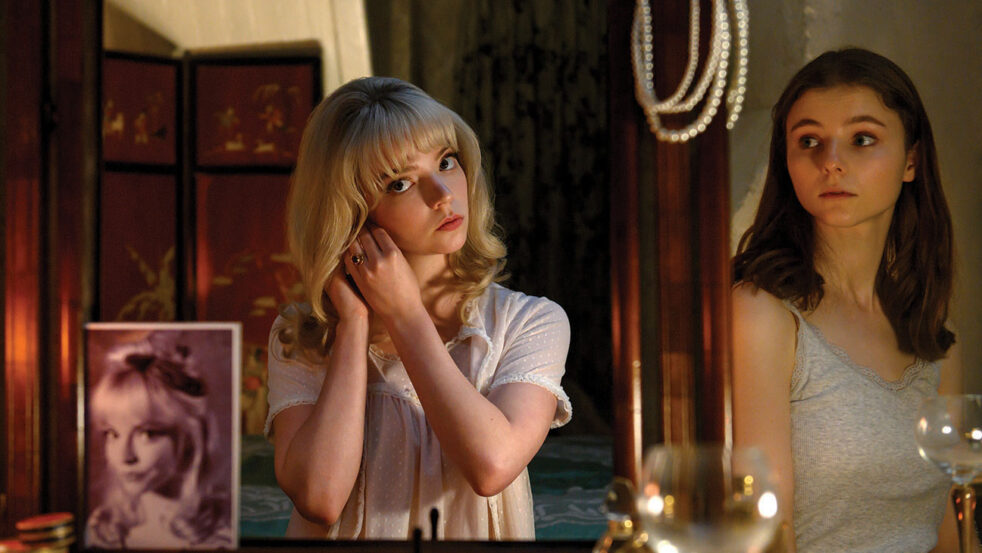Our Take: 4/5 Stars
Edgar Wright, a director known for works like “Shaun of the Dead” and “Scott Pilgrim vs. the World,” tells a dark and dazzling tale with “Last Night in Soho,” starring Anya Taylor-Joy (“The Queen’s Gambit”) and Thomasin Mckenzie (“Leave No Trace”).
“Last Night in Soho” closely resembles a modern day Alfred Hitchcock thriller. Just as Hitchcock’s signature was to build up suspense, “Last Night in Soho” is a slow burning but exhilarating watch. As the narrative progresses, it transitions from a coming of age film and descends into a tale of mind games and paranoia that keeps the audience at the edge of their seats.
“Last Night in Soho” is about a young fashion student named Eloise who leaves her rural home in Cornwall and moves to London for school. Both her life and fashion are heavily influenced by the 1960s, which is evident visually throughout the film. It is at fashion school where Eloise discovers the nightlife in Soho and the story takes the viewer into a world of both dreams and nightmares.
The 1960s are heavily referenced throughout the film as Eloise, who was already inspired by the time period, becomes even more infatuated when her dreams focus on a wannabe singer named Sandie (Taylor Joy) and talent manager Jack (Matt Smith, “The Crown’’). It is then that Sandie’s past starts to affect Eloise’s present life.
The ‘60s even inspired the name of the film itself, as the title originates from a 1968 single by the English pop band Dave Dee, Dozy, Beaky, Mick & Tich. It was also inspired by a conversation Wright had with filmmaker Quentin Tarantino, who was told by director Allison Anders that “Last Night in Soho’’ was the “best title music for a film that’s never been made.” The soundtrack continues with the 60s theme both in the present day, as Eloise is a fan of older music, and in the past, as Sandie is an aspiring singer from that time period.
The true gems of “Last Night in Soho” are the camera work and costumes. The visual effects and editing help blur the line between the past and present in an energetic way. The camera works to make the setting feel both based in reality and other worldly depending on the mood of the protagonist. It is also a point to mention that there are various dance scenes in the movie that were all filmed in one take. This is especially impressive with the complex choreography and the switching between dance partners that were seamlessly captured on camera.
As for the costuming, the ‘60s were full of bright colors, mini dresses, dapper suits and sleek hairdos, and these aesthetics are all reflected in “Last Night In Soho.” As the film goes on, Eloise’s fashion evolves from a conservative and floral-heavy style into full-blown ‘60s meets modern Londoner as she incorporates more bold elements into her fashion. However, Taylor-Joy’s Sandie is the true star when it comes to costume design, as she represents the various ‘60s fashion trends with her iconic blonde beehive hairdo and peach chiffon dress.
The film’s costume designer Odile Dicks-Mireaux said she studied dozens of films from the 60s to understand the vibe and was also influenced by the styles of Brigitte Bardot, Julie Christine and Cilla Black. She also looked at photos of historic Soho in order to learn about people dressed for the nightlife.
Anya Taylor-Joy was a perfect choice for Sandie and she was mesmerizing to watch as she seamlessly switched from free spirited and spunky to something much darker as the plot progressed.
Thomasin McKenzie did a great job of showing a huge range of emotions from naivety to paranoia; and Matt Smith was suave and charming.
Overall the cast worked well together and it felt very fresh and natural to see these characters on screen together.
Edward Wright is known for his fast paced and witty dialogue but at times it moves too quickly, which can be difficult for some viewers, especially given the different accents of the cast. Another potential downside is the film’s pacing. Most of the film’s action takes place towards the final 40 minutes, but the wait helps to build up suspense.
Overall, while the film is a little slow-paced, the ride is very much worth it in the end, especially with all the twists and turns. “Last Night in Soho” is an interesting and unique take on the psychological thriller genre.
